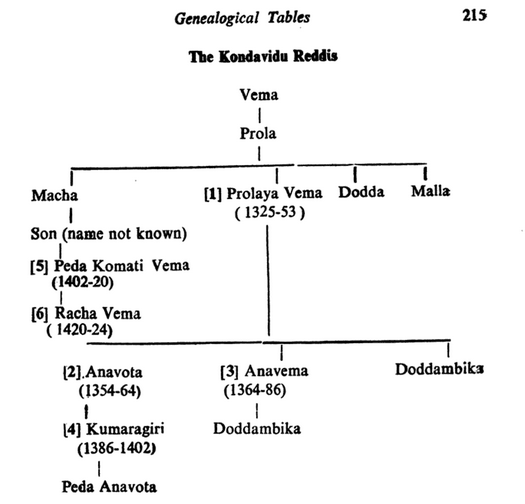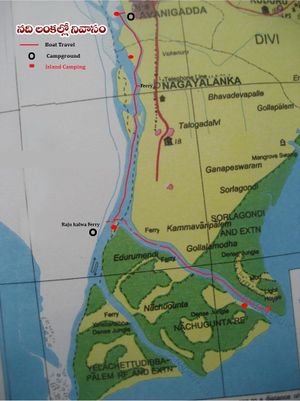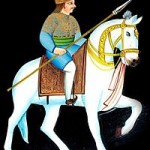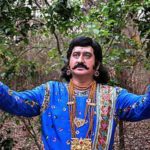The next great King of the Reddi Kingdom was in fact the greatest King of the Dynasty. Though most people don’t know much about him today, likely due to the reputation of the royal founder, this Reddi ruler revived the reputation of the Rajyam and greatly expanded it. The next great Andhra Personality in our Continuing Series is Anavema Reddi.
Before we review his biography, however, it is important to understand the context of his reign.
Background
Anavota (Cir.1353 CE to Cir.1364 CE)
The next ruler after Prolaya Vema was Anavota Reddi —sometimes written as ‘Anapotha’, who ruled from 1353 to 1364. After succeeding his father as King, he shifted the capital from Addanki to Kondaveedu, the city which later became legendary for its “Kondaveeti Raja”. He did this to protect the kingdom from Vijayanagara expansion. Attacked on all sides (Gangas from the North, Recharlas & Bahmani Alliance from the West, and Vijayanagara from the South, Anavota’s main achievement was keeping the Reddi kingdom together. His minister Mallaya Vema inflicted a crushing defeat on the Bahmanis, who had desecrated the temple of Dhanyavati (after they did the same at Pillalamarri in Telangana). After the victory, Reddi reconsecrated Lord Amaresvara at Amaravati.
Anavota was highly successful in his Kalinga campaign, and is thought to have gone to the heart of Odisha (it is not known how strong his sway was, but it likely did not last long). On his return he gave a gift of bells to Lord Bhimesvara of Daakshaaram. He was called Veer-Anavota and also improved the port facilities at Motupalli. He gave many agraharas to Brahmanas, and much charity to the populace in general, and established feeding houses and other measures for the welfare of the people. “He strove hard to establish order in the country and to revive the dharma of the land“.[3, 105]
Nevertheless, because Anavota’s son Kumaragiri was still a minor, the latter’s uncle Anavema Reddi, succeeded to the throne. He is considered the greatest King of the Reddi Rajyam.
Anavema (Cir. 1364 CE to Cir.1386 CE)

Anavema Reddi was the third son of Prolaya Vema. The middle son was Anamacha (who is said to have died young). As such, Anavota’s brother took the throne and revived Reddi Rajyam’s fortunes.
The first thing Anavema did was consolidate his alliances. His brother-in-law Bhimadeva Choda was locked in fratricidal conflict with Choda brother Annadeva. The Reddi king’s first aim was to restore Bhimadeva to Nidadavolu. The need for this was further compounded by pressure in the south from Vijayanagara, so Anavema turned north. He first invested and took the island fortress of Divi. He then followed this up by conquering Niravadyapuri (Nidadavolu), Rajamahendri (Rajahmundry), Pithapuram, and Simhachalam from the Gangas of Odisha. He fought many battles with the Recherla Rachakonda Rajas.
The Wazirabad (Vadapalli) inscription dated to Saka 1299 records one battle in particular between the Recerlas and the Reddis. “This record proves that Anavema scored a decisive victory over the Recerla chiefs, and annexed to the Kondaveedu kingdom, at least a portion of the dominion lying to the north of the Krsna.” [3, 119]. The Boorugugadda inscription in Nalgonda provides further evidence.
Despite his military exploits and strategic acumen, Anavema was also a man of culture. He would be gifted many titles, including one that would later become synonymous with his successor.
Achievements

“Of all the titles of Anavema in this record, the first that claims our attention is Deevi-durga-vibhaala, the breaker of the fort of Deevi, or Dveepa.”[3, 113]
Anavema was first and foremost a conqueror. His achievements in not only consolidating but expanding the kingdom extended the dynasty’s glory for several generations.
He was called Raajya-ramaaramanee-svarayamvara-labdha-naayaka-saubhaagya, which means one who had the good fortune to be chosen king by the sweet goddess of the state. Thus, he likely was the popular choice of the nobles of the kingdom to restore the fortunes of the Reddi Rajyam. [3, 110]
He protected the Reddi kingdom and re-established its power at a critical juncture. In his Srisailam record, he was referred to as “Saagara-Gautamee-salila-sangama-sakala-jaladurga-saadhana-Raghuraama (a Raghuraama in subduing all the jaladurgas situated at the confluence of the sea and the waters of the Gautamee). Anavema was thus a skilled besieger having taken all these water-forts. [3,112]
He was a skilled diplomat, as “Anavema secured, in this campaign, the co-operation of some of the Reddi nobles like Kaataya Reddi II and Maaraya Reddi II, sons of Maaraya I and grandsons of Kaataya I, and Doddaa Reddi and his brothers of the Duvuri family, some of whom were his close relatives. Of these Kaataya Reddi II had the significant title of jaladurgamalla because of his special skill in reducing the jaladurgas.”[3,116] This facilitated Anavema’s conquest of Rajamahendravaram.
Anavema defeated the pillaging and fierce Manne tribal chiefs who made predatory raids on their frontiers. He put and end to their expeditions.
His eastern campaign ended in 1375, and he took the title Simhaachalaadi-Vindhyapaada-pratishtaapita-keerti-stambha, which means one who planted pillars of fame at Simhachalam and other places at the foot of the Vindhyas. [3, 117]
The Borrugugadda inscription marks the western limits of the Reddi kingdom, and signifies the conquests Anavema made in the Recherla territory in Telangana. He is said to have avenged his brother and defeated them. Thus, the Reddi kingdom was enhanced during his reign.
Anavema is said to have taken delight in the company of great poets, and revived many cultural celebrations (later taken to their peak by his successors).
He gave patronage to many learned men and is praised by Vennelakanti Surana (author of Vishnu Puranam) for his generosity and cultivation of learning. His Birudas (cavaliers/knights) protected the nobles of the Panta Reddi clan, and his Naya (political wisdom) protected his people.
Finally, he like his brother Anavota, granted a gift of bells. These gaja-ghantaa were given to the five holy kshetras (panchaaraamas), which are Amaraamaa (Amaravati), Daakshaarama, Ksheeraaraama (Palakol), Kumaaraama (Saamalkot, and Bheemaraama (Gudipudi).
He realised the dreams of his father to bring all of coastal Andhra under one sceptre. His accomplishments are found in the Catu Sanskrit verse which states that:
“people got good food, fine clothes, musk, gold & chowries while he was the king of the land“. [3,121]
Legacy

“King Anavema was the greatest of the Reddi rulers of Kondaveedu. He came to the throne by the choice of the ministers and nobles of the state at a time when its fortune was at a low ebb. He assumed the title mahaneeya-andhra-desa-pattaabhiseka-samvrta-mahaabhaagya, ‘he who had the great good fortune of being crowned king of the glorious Andhra country‘”.[3,120] He repaired the loss sustained by the kingdom prior to his coronation, and enhanced its glory by his conquests. In his time, the power of Kondaveedu reached its zenith. It extended from Sreesailam to the sea, and from Kandakur to Simhaachalam”[3,120]
The importance of King Anavema, therefore, cannot be minimised.
Anavema was a just and righteous ruler…He was famed for his liberality and munificence. He devoted his wealth chiefly for the encouragement of learned men and gloried in their eloquence and scholarship. [3, 121]
The real pity, of course, is that our artists (amateur and professional alike) have no time to celebrate such great historical figures. Anavema and Prolaya Reddi and Prolaya & Kapaya Musunuri before them, deserve to be memorialised in paintings and sculptures (or at the very least sketches). When you forever take inspiration from the foreign, you forget the importance of remembering the native.
Great men, great kings, and great Andhras like Anavema deserved to be remembered, not only for their military and political achievements, but for the culture and language they helped defend and nourish.
https://www.youtube.com/watch?v=bkeXQB0fURA
References:
- P. Ragunadha Rao. History and Culture of Andhra Pradesh.Sterling: Delhi.18
- Prasad, Durga. History of the Andhras. Don Bosco Press: Guntur. 1988
- Malampalli, Somasekhara Sarma. History of the Reddi Kingdoms.Delhi:Facsimile Publ. 2015







nice information, i like it very much, i just would like to say only, keep it up like this only, and give us information like this,
Absolutely loved it. I’m naming my 1st son after this guy.
Thanks. It appears you have a notable name too, so it would be a family tradition of great political names 😉 . Anyway, we appreciate your comment. Glad you enjoyed the article—hope the rest of the series is also to your liking.